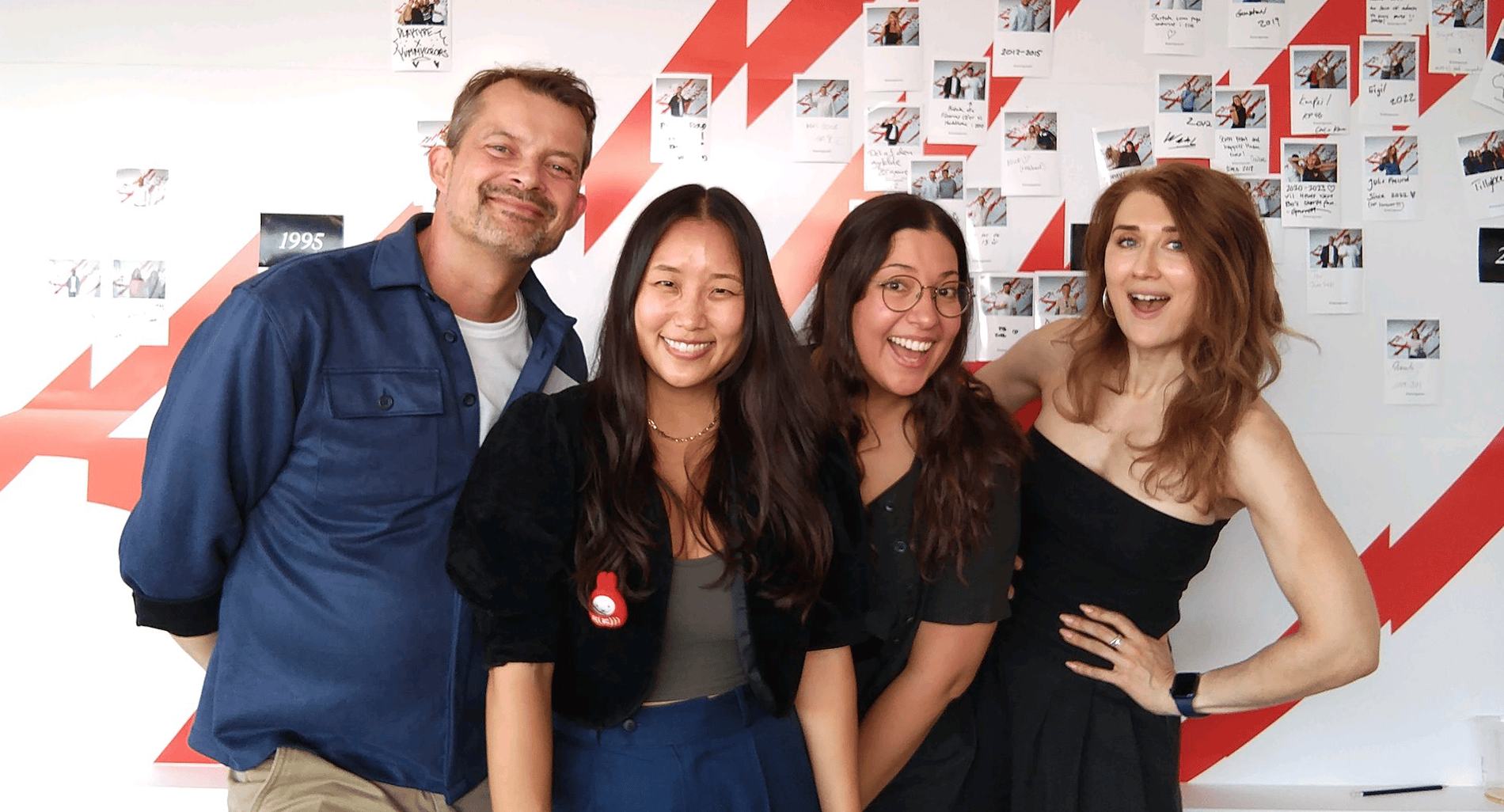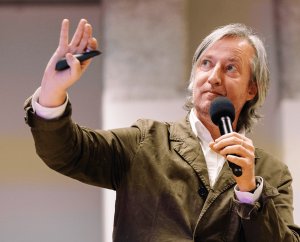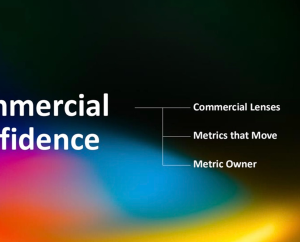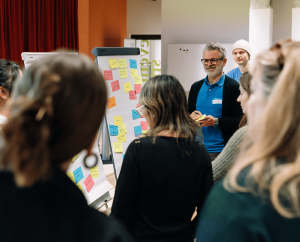A Question in the Dark
The lights dimmed at Copenhagen’s Cinemateket as an AI-generated film by co-host Tey Bannerman flickered to life. The hum of anticipation gave way to the screen’s glow, and a question that echoed throughout two days of talks, workshops, and community:
What is the future of design?
As the board’s futures advocate, Alicia Shao felt a spark. After months of curation, the program had come together, timely, relevant, and refreshingly human.
For the first time in Design Matters’ history, we opened a public call for talks. Submissions poured in from around the world, reviewed, rated and debated by the board. Then our spreadsheet sorcerer, Tey Bannerman, worked serious magic to weave the unanimously approved program.
In an era when designers must navigate the rise of AI, the fear of being outpaced by AI is real. But many of the speakers challenged the narrative, reminding us that design is never passive. Determinism isn’t destiny. Not when designers are present.
“There’s a lot of fear about AI, and a lot of fear about jobs,” co-host Tey shared in his opening remarks. “But there’s also a lot of opportunity and excitement. That’s what this conference is about.”
Design invites interpretation. It can slow systems built for speed. It can bring emotional intelligence when nuance is flattened into data points.
We’ve been here before. The internet, too, was framed by a myth of inevitability: “It’s going to change everything—whether we like it or not.” That mindset excused design negligence, regulatory gaps, and ethical shortcuts. Today, we hear echoes of it again: “AI is coming for every job. Better get used to it.”
But history reminds us: what feels inevitable is often just what went unquestioned. The future remains open to those willing to question, resist, and redesign.
How We Came to Design Matters
Alicia, Becca, and Mónica each joined the Design Matters team in different ways.
Alicia spoke at Design Matters 24. When Michael invited her to join the 2025 board, she was thrilled— “finally, a taste of real power.” As the board’s advocate for design futures, she helped shape a thoughtful and deeply human-centered program.
Becca attended DM24 and immediately knew she wanted to be part of the team building this global community of creatives. This spring, she joined the team as project coordinator, focusing on speaker management and production.
Mónica had followed the Design Matters newsletter and, eager to join the design magic, reached out. She joined this spring as a project assistant, focusing on ticket campaigning, attendee touchpoints, and managing volunteers.
Powered by People
Behind the scenes were 13 mighty volunteers who helped bring everything to life. From early setup to last-minute logistical puzzles to heartfelt goodbyes, they were the connective tissue of the event. A mix of returning and first-time volunteers, they jumped in with heart and hustle.
This reminds us: it’s people who make it matter.
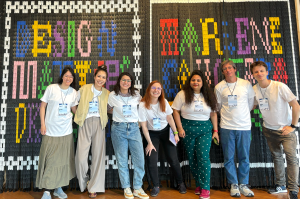
Design and Debate
Through lively debate, the board brainstormed on the big questions: What’s needed now? What’s worth amplifying? What’s missing?
The goal? No tech doom, no utopian fluff— just grounded, urgent perspectives that help designers navigate the murky middle. From there, four conference tracks emerged: Steps Forward, Design Rehab, Equipping New Craft, and Design in Democracy.
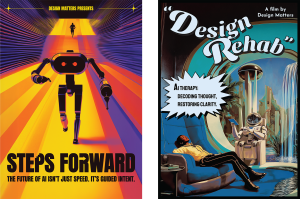
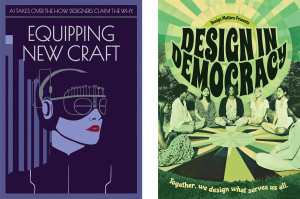
These themes helped the entire experience feel cohesive and human. That human thread echoed through logistics, content, and the atmosphere.
A Space for Connection, Curiosity, and Critical Conversation
Cinemateket was more than a venue—it amplified the experience. As our co-host Rahul Lindberg Sen said: “This is a legendary venue […] where movies and cinema are celebrated every day[…] how cool is it that we get to talk about design in this [space].”
To that, we add: in a place all about storytelling!
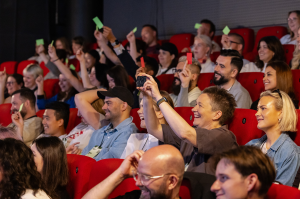
Cinemateket invited us to tune out the noise and lean into meaningful stories. There was a relaxed yet exuberant energy among attendees and speakers. A shared understanding that we weren’t just here to consume content but to reflect, challenge, and connect.
“What I love about this event every year”, said Rahul, “is the kind of community it brings together.”
Tey echoed, “Design Matters is where you come to connect with people, where you come to learn, […] for that pure joy and excitement. I think that’s what this is about.”
Embracing Play, Purpose, and Imperfection
This year’s workshops didn’t just teach—they invited reflection, play, and connection. They gave space to experiment, check our perfectionist tendencies, and embrace imperfection with creativity.
Amy Grinstead explored how voice and tone shape product experiences. Marlene Couceiro took us beyond the screen with hands-on pixelated tile-making, and her giant mural welcomed us at the entrance.
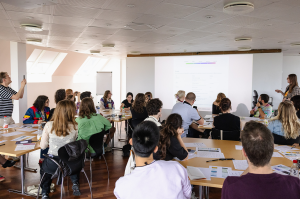
La Diseñería hosted a vibrant networking session fueled by curiosity cards and candid, creative conversation.
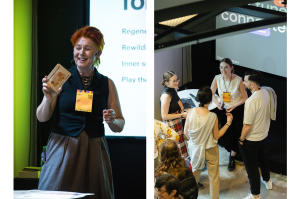
Day 2, brought more play: Niche Chathong turned brainstorming into a game; Anna Taws guided us back to nature through regenerative design; Çiğdem Demir created a space to unpack perfectionism—and a perfectly imperfect gallery wall to prove it. Jakub Svehla made the case for motion design for clarity, not just visual flair.
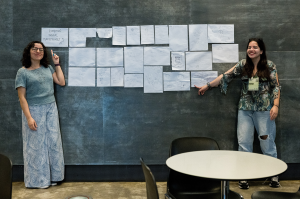
Each session echoed the conference’s heart: design is a process, people, and participation.
The Pulse of Design Talks
Working behind the scenes, Mónica caught fragments that stayed with her. Will Shaw’s (EY Studio+) declaration: “We are the architects of our lives.” A reminder that tech doesn’t define us. How we use it does. Caroline Fletcher (EY Studio+) added: “In moments of high emotion and complexity, people don’t just want a solution—they want to be heard, seen, and understood. We call this empathy demand, and we believe it will be a cornerstone of future AI design.” Their talk showed how designers can embed empathy, responsibility, and meaning into AI systems, proving that thoughtful design can shape tech that truly serves people in their most vulnerable moments.
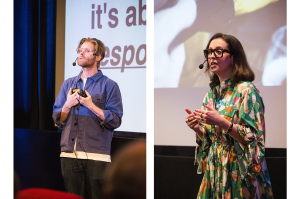
Becca found three threads across the talks:
1. The Future Is In Our Hands
Despite AI anxiety, we’re still the hands behind the machine.
PJ Richardson and Jaryn Bunney encouraged proactive and joyful uses of technology.
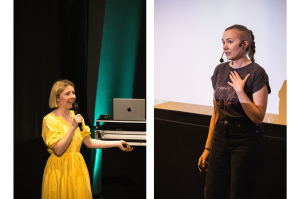
Jean-Baptiste Kaloya outlined the creative personas designers can adopt. Ram Yoga shared frameworks for communicating with decision-makers. Silvia Testa promoted inclusive ethical design and technological features with consideration of marginalized communities. Hanna Norlin urged us to imagine seemingly unfathomable futures and utopias because, historically, we’ve always done so, and we must do it again. Liz Pomeroy emphasized user empowerment and co-creation with AI, reinforcing the idea that designers still shape outcomes, even in unpredictable systems. Emil Spangenberg and Thomas Christensen‘s session emphasized human creativity in AI workflows. Prompting showcased how designers maintain authorship and agency by experimenting, refining, and shaping outcomes.
2. Make Way for Creative Strategy
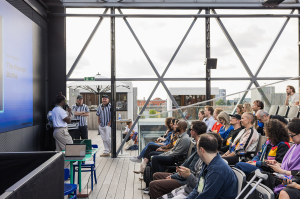
Design’s influence is growing. Natalia Kritsali demonstrated how strategic design can shift public systems: using culture, trust, and service to change behavior, not just screens. Anneli Hansson called for strategic designers as decision-makers and highlighted how strategic design can reshape industries. Eason Yang reframed perceptions of cancer survivors and their caregivers returning to the workforce. Melanie Bos exemplified that humor and authentic voice debunk stigma in sexual wellness marketing.
Bo Linnemann (Kontrapunkt), Ben Terrett, and Kaave Pour explored how civic design builds public trust, which shaped their design concepts that won them notoriety and recognition across Europe and the UK.
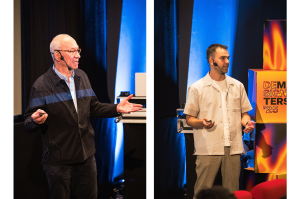
Rebekah Cheng shared innovative community workshops that continue to serve their neighborhood in Japan. Gaëlle Le Gelárd promoted design-led circular economies as climate solutions. Patrizia Gómez-Jurado emphasized how content design can shape strategy, turning writers into core product partners, not afterthoughts.
3. Be human, be kind
Empathy is a strength. Fergus Inns reminded us that kindness makes us better designers.
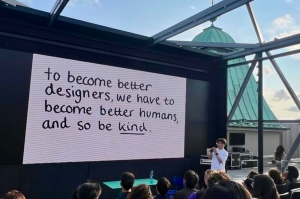
Personal stories brought the message home. Our anxieties and fears, hopes and dreams – provide a space for community and interconnectedness. Kot Bonkers transformed anxiety into artful connection, reminding us we are not alone. Hanna Benihoud unpacked the highs and lows of public art. Jian Wei created a moving metaphor, shown through the bus driver’s eyes. Marie-Claire Dean shared slow, immersive art and experiences to deeper self-connection. Valentina D’Efilippo revealed how data design can shift emotion, turning numbers into meaning.
The message was clear: prioritizing processes that let us be soft, human, and curious brings out the best in our craft.
Conclusion
As the final talk ended and the lights came up, we felt it: a quiet pride. The spark had become something real. Something shared.
The closing reception offered an opportunity to share final moments with new and old friends.
Design Matters 25 didn’t just talk about the future. It offered glimpses of it. Through tools, talks, and tactile experiences, the message rang clear: We don’t compete with AI. We shape it.
And, the systems we build must reflect human values. Ones that are emotionally aware, ethically grounded, and unmistakably human.
Design Matters 26 planning begins in August. If you’re thinking, “Maybe next year,” this is your sign.
The future isn’t inevitable. It’s human.
Let’s keep it that way.
Becca Kang: LinkedIn | Instagram
Mónica Bastos: LinkedIn | Instagram
Alicia Shao: LinkedIn | Website
Movie Poster: A robot gliding confidently ahead, while a human sprints behind, joystick flailing. Are we steering technology, or is it running away with us? In a world of relentless innovation, predictive design, and decentralized systems, the poster nudges us to ask, how can we shape our tools with intention instead of chasing after them breathlessly?
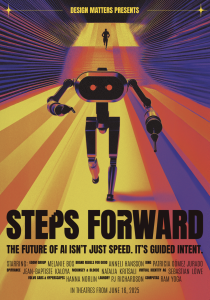
Theme 2: Design Rehab
Description: Our design community needs a sanctuary for self-awareness where we pause to reflect on our values, goals, and the “why” behind our work. By examining personal strengths, identifying burnout triggers, and rediscovering intrinsic motivation, designers can heal creative fatigue and rebuild purpose. This dialogue fosters creativity, improving society, and professional impact.
Key words: Design Therapy, Recharge & Community
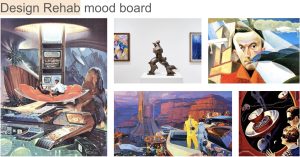
Movie Poster: A human reclines on a therapist’s couch; the therapist, a robot, listens intently, pen poised. In this imagined future, AI isn’t just a productivity booster, it’s our creative caretaker, our burnout buffer. Can we let go of the myth of endless hustle? Could our most powerful design tool be the one that helps us slow down, reflect, and recover?
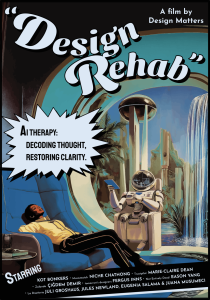
Theme 3: Equipping New Craft
Description: How to gear up for the design era of intelligence? This new era of design demands a well-stocked utility belt of skills, fresh processes, innovative approaches, and adaptability. We need to unlearn outdated practices, master emerging technologies, and arm ourselves with skills that are needed for the future.
Key words: New Era, Skills & Practical Tools
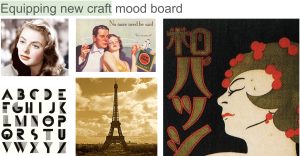
Movie Poster: A human wears a sleek neural headset, eyes closed, as the world around them reshapes itself in real time. Thought becomes craft; imagination becomes artifact. In this future, AI handles the execution while humans become master storytellers, dreamers, and provocateurs. But are we ready to shift from ‘making’ to ‘envisioning’? Can we wield these new tools without losing ourselves in the process?

Theme 4: Design in Democracy
Description: We must reflect on the legacy of design. By exploring how design disciplines have empowered individuals, strengthened communities, and driven societal progress, we can evaluate their impact on democracy. By looking back, we can draw inspiration that helps us move forward to create a better, more inclusive future.
Key words: Legacies, Democracy & Transformation
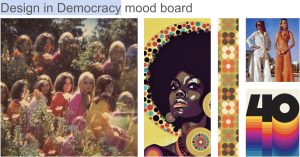
Movie Poster: A circle of people, designers, activists, neighbors, huddled together, hands busy, ideas flying. This poster whispers of a future where design isn’t solitary or siloed; it’s collective, cooperative, gloriously messy. How do we build democratic spaces where everyone’s voice shapes the work? What might it mean to design with people, not just for them?
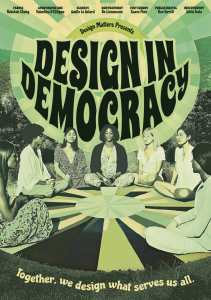
Prompting Design Comunity Conversations for an Uncertain Tomorrow
These Four Futures aren’t crystal balls. They’re invitations. They challenge you to think, to talk, to imagine. Because when we confront uncertainty head-on, when we play with it, question it, even laugh at it, we loosen its grip on our creativity. We make space for resilience, for invention, for hope.
We invite you, dear designers, to join us at Design Matters 25, wander through these imagined worlds, and join the conversation. Because if we’re going to navigate the unknown, we might as well do it together, with wit, with curiosity, and with a touch of cinematic flair.
Let’s step boldly into the unknown. It is a lot less frightening (and a lot more fun) when we do it side by side.
***
All four future mood boards were compiled by Adilice Sanches
All four future posters were designed and created by Sara Bertova


